Troides helena spilotia (Linnaeus, 1758)- »n»ñ½º - Common Birdwing
| Distribution | Phenology | Conservation | Plates |
The following information on Troides helena is extracted from a paper by J.J.Young & G.T.Reels (Young, J.J. & Reels, G.T., 1998. A brief note on the distribution and conservation of Birdwing butterflies in Hong Kong. Porcupine! 17: 10).
Troides helena (Linnaeus) and Troides aeacus (C. & R. Felder) are the only two representatives of the so called Birdwing butterflies in Hong Kong. T. helena is the commoner of the two with T. aeacus only recorded in the last 10 years
Distribution
In Hong Kong Troides helena is at the northern limit of its range, which includes Nepal, India, Thailand, Malaysia, Indonesia and Vietnam. Though widely distributed, helena is not common in Hong Kong.
The two species are found in various scattered locations throughout Hong Kong. Three sites in the New Territories have been identified and consist of a stable population. They include the surrounding area of Po Lo Che (Sai Kung), Shan Liu Road (Tai Po) and Kadoorie Farm & Botanic Garden. Both species are found in Kadoorie Farm and Shan Liu Road but only helena appears to fly in Po Lo Che. Fung Yuen Village in Tai Po was in the past a sanctuary for the Troides. Now, the Troides have almost gone as the abundant foodplants (namely Aristolochia tagala Champ.) of the butterflies in Fung Yuen have meticulously disappeared. At the same time, the village has undergone the ever increasingly rural development and which definitely depletes the entire population. Other sightings of the butterflies may include Tai Po Kau Nature Reserve in Tai Po, Hok Tau Reservoir in Fanling, Ho Chung and Wong Chuk Yeung in Sai Kung. Sometimes, a few Troides can be seen in Ho Chung but such sightings do not seem to be recurring.
Troides helena occurs on the Lantau Island as well. It is found mainly around the path from Po Lin Temple to Tung Chung. A. fordiana Hemsl. appears to be the hostplant for T. helena in this area.
One may even find Troides on the Hong Kong Island as the foodplant appears to exist in the Tai Tam area surrounding the Hong Kong Parkview. A similar butterfly, Pachilopta aricholochiae (Fabricius) feeding on the same foodplant as the Troides was recorded in Tai Tam Country Park just around the corner from Hong Kong Parkview in 1994.
Phenology
The butterflies are multivoltine and have many generations in a year. They are generally on the wings from March to November. When they are in season, a few butterflies can be seen flying together. In one instance, 5 Troides were recorded in an hour's interval in Shan Liu Road. Three of them were males and one of the females was Troides aeacus.
Conservation
One of the reasons that the number of birdwing butterflies has decreased drastically in the world is due to the more extensively collecting by irresponsible collectors. In Hong Kong, this situation does not seem to exist. In fact, the birdwings in Hong Kong appear to have increased in numbers. The detrimental cause of depletion of the Troides species in Hong Kong if any will probably be the ever increasingly rural development which will completely destroy the breeding sites with the only food source of the butterflies.
The Troides in particularly are very selective in their food source. They feed only on the fruits and leaves of Aristolochia tagala (Champ.) [Aristolochiaceae], a climbing vine found generally in the New Territories. With the ever increasingly rate of rural development going on in the New Territories, their foodplants are diminishing rapidly. As their appetite is enormous, large number of foodplants are required to sustain a healthy population. Efforts have thus been put in the conservation of the two Troides in the Kadoorie Farm and Shan Liu Road where Aristolochia tagala has been planted to provide ample food source for the butterflies. New breeding sites have been planned with the planting of the hostplants for the butterflies which will at the same time be artificially reared and transferred to such sites for regeneration.
Plates
|
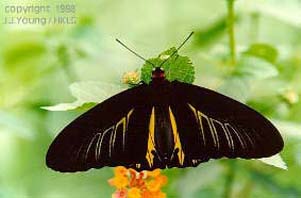
|
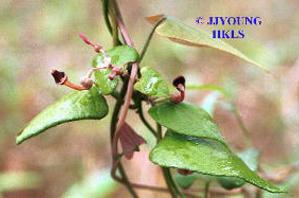
|
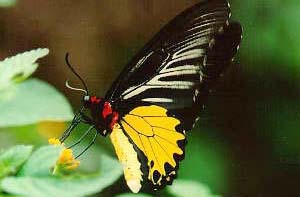
|
| Male |
Aristolochia fordiana Heml. (now
confirmed to be host plant) |
Male Troides helena feeding on Lantana camara |
|
|
|
|
|
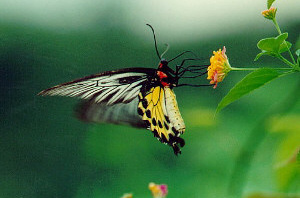
|
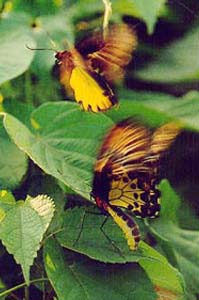
|
|
| Female Troides helena feeding on Lantana camara |
A courting couple - the male is above, presumably wafting pheromones; over the female as incentive to couple |
|
|
|
|
|
This page was created on 29th November 2000.
©2004 Hong Kong Lepidopterists' Society Limited
|